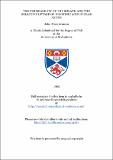The permeability of the sheath and the selective uptake of nicotinic acid in crab axons
Abstract
1. Peripheral nerve from the crab walking leg was seen to take up nicotinic acid (NA) to an extent ten times greater than the surrounding tissues (p.37). 2. After a labelled dose of NA there was a gradient of radioactivity in the nerve trunk with the maximum peripherally (p.40). 3. Individual fibres from the trunk were seen to take the *NA up in equal amounts, irrespective of their function (p.47). 4. No such gradient was seen in a length of nerve immersed in a bath containing *NA (p.45). 5. A substance was extracted from the nerve after injection of the *NA which was radioactive (p.49), and which was seen to have reactions of a small peptide (p.57). 6. This substance was also seen to have an accelerating effect on the crab heart, but had no detected effect on the contractions of the closer muscle in the leg (p.68). 7. In the second part of the thesis, results show that there is no difference in the structure of the sheath around the different motor axons in the crab leg, as seen under the light microscope (p.108). 8. When the potassium concentration around an isolated axon was changed to three times its normal value, the resulting drop in the membrane potential and resistance was slower and smaller than for any other concentration tried (p.113). 9. The effect of applying to single fibres dinitrophenol and other compounds of pharmacological interest was studied; with the dinitrophenol the membrane resistance was seen to fall reversibly in the manner described for other preparations (p.120).
Type
Thesis, PhD Doctor of Philosophy
Collections
Items in the St Andrews Research Repository are protected by copyright, with all rights reserved, unless otherwise indicated.

